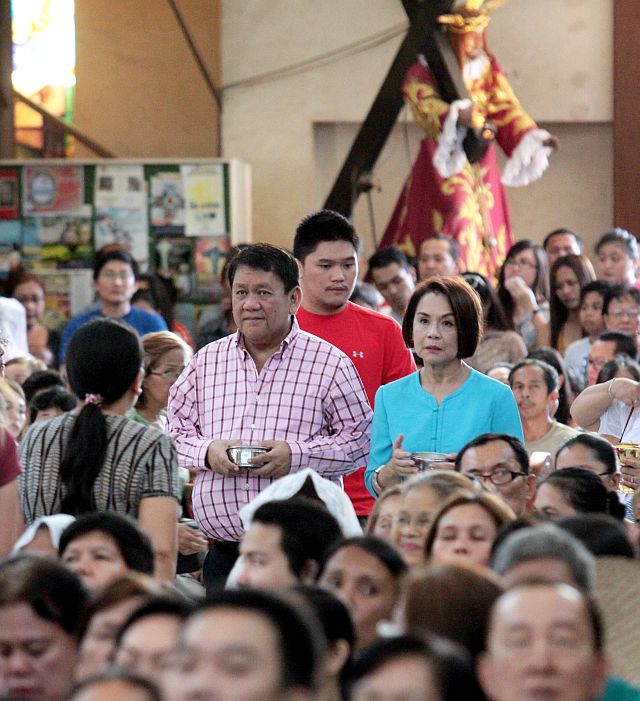
Former mayor Tomas Osmeña and his wife Councilor Margot, with Rep. Samsam Gullas behind them, join the liturgical celebration where they offer wine and sacred host. (CDN PHOTO/JUNJIE MENDOZA)
Thousands of people trooped to barangay Guadalupe in Cebu City yesterday to celebrate the feast of Cebu’s patroness.
In a Mass he presided, Cebu Archbishop Jose Palma urged the faithful to turn to Mary and to never lose contact with her.
“She is our mother. And as we thank her for bringing Jesus in our midst, may we become like her son too,” the prelate said in his homily.
Concelebrating with Palma were Bishops Antonio Rañola and Christian Noel and 30 priests.
Former Cebu City Mayor Tomas Osmeña and his wife Margot, both residents of barangay Guadalupe, attended the Mass and offered the host and wine during the liturgical celebration.
Cebu Archbishop Jose Palma uses incense to bless a pre-Spanish image of Our Lady of Guadalupe during fiesta mass. (CDN PHOTO/JUNJIE MENDOZA)
Also present was Rep. Gerald Anthony “Samsam” Gullas of Cebu’s 1st district.
Before the end of the Mass, Palma placed incense on the original image of Our Lady of Guadalupe de Cebu as the congregation sang Salve Regina (Hail Holy Queen).
The devotion to Our Lady of Guadalupe started in Mexico.
In 1521, Portuguese explorer Ferdinand Magellan gave as baptismal gift an image of Our Lady of Guadalupe to Cebu’s natives.
In 2002, then Archbishop of Cebu Ricardo Cardinal Vidal declared her the principal patroness of Cebu.
The Cebu City transportation Office (CCTO) said traffic heading to the Archdiocesan Shrine of Our Lady of Guadalupe de Cebu was manageable.
CCTO operations chief Joy Tumulak said they expected traffic to be heavy at night when the fiesta celebration goes full swing.
Fifteen enforcers were fielded.
The small wooden image of the Virgin Mary was found in a cave in the hills of what was then barangay Banawan, in what was the old town of San Nicolas, circa 1700s, according to Louie Nacorda, a Cebu heritage writer and Catholic icongrapher.
The finding led many Cebuanos to the cave to pray and collect water that drips beside the image.
The image resembles the one in Mexico that was imprinted in St. Juan Diego’s “tilma” or cloak in 1531, minus the rays hence, it was called Our Lady of Guadalupe de Cebu.
It was dark in complexion and carved from tugas (molave) wood. It sculptural sytle showed it was a work of Filipino folk culture.
The pre-Spanish image of Our Lady of Guadalupe. (CDN PHOTO/JUNJIE MENDOZA)
The Virgin is dressed in red, with a blue mantle covering her head, cascading down to her feet.
She stands over a quarter moon and three cherubs.
Stories of miracle cures and intense devotion have built up over the centuries.
A cholera epidemic in Cebu in 1902 dramatically ceased and was credited to a daily dawn penitential procession by residents of Guadalupe who invokedGod’s mercy through the intercession of the Virgen of Guadalupe de Cebu.
This was done for 90 consecutive dawns and the death toll ceased, wrote Nacorda.
In the cave, a copy of the Marian image was installed. On July 16, 2006, the Vatican recognized the great Cebuano devotion to the Virgen de Guadalupe de Cebu, and authorized its canonical coronation.